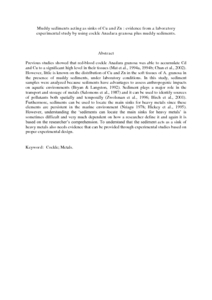Citation
Yap, C.K. and Muhamad Azlan, A.G.
(2010)
Muddy sediments acting as sinks of Cu and Zn : evidence from a laboratory experimental study by using cockle Anadara granosa plus muddy sediments.
Malaysian Applied Biology, 39 (1).
pp. 49-52.
ISSN 0126-8643
Abstract
Previous studies showed that red-blood cockle Anadara granosa was able to accumulate Cd and Cu to a significant high level in their tissues (Mat et al., 1994a, 1994b; Chan et al., 2002). However, little is known on the distribution of Cu and Zn in the soft tissues of A. granosa in the presence of muddy sediments, under laboratory conditions. In this study, sediment samples were analyzed because sediments have advantages to assess anthropogenic impacts on aquatic environments (Bryan & Langston, 1992). Sediment plays a major role in the transport and storage of metals (Salomons et al., 1987) and it can be used to identify sources of pollutants both spatially and temporally (Zwolsman et al., 1996; Birch et al., 2001). Furthermore, sediments can be used to locate the main sinks for heavy metals since these elements are persistent in the marine environment (Nriagu 1978; Hickey et al., 1995). However, understanding the ‘sediments can locate the main sinks for heavy metals’ is sometimes difficult and very much dependent on how a researcher define it and again it is based on the researcher’s comprehension. To understand that the sediment acts as a sink of heavy metals also needs evidence that can be provided through experimental studies based on proper experimental design.
Download File
![[img]](http://psasir.upm.edu.my/15745/1.hassmallThumbnailVersion/Muddy%20sediments%20acting%20as%20sinks%20of%20Cu%20and%20Zn%20%20evidence%20from%20a%20laboratory%20experimental%20study%20by%20using%20cockle%20Anadara%20granosa%20plus%20muddy%20sediments..pdf)  Preview |
|
PDF (Abstract)
Muddy sediments acting as sinks of Cu and Zn evidence from a laboratory experimental study by using cockle Anadara granosa plus muddy sediments..pdf
Download (151kB)
| Preview
|
|
Additional Metadata
Actions (login required)
 |
View Item |

